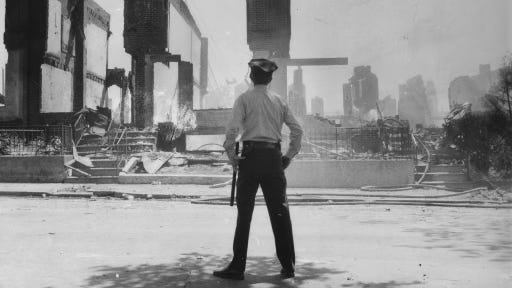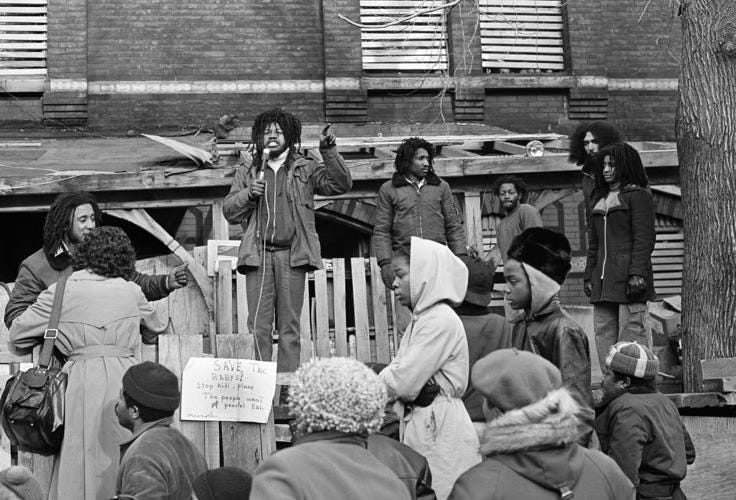Tragedy and Travesty: The Murders on Osage Avenue
Regarding the MOVE Bombing on the 40th anniversary.
“You hear about Ruby Ridge. You hear about Waco. But you don’t hear about Osage Avenue,” James Taylor told his local NBC affiliate in Philly this week. “All happened around that same time. You never hear about Osage Avenue. I wonder why?”
We know.
Forty years ago today, the government of Philadelphia dropped a bomb on its own citizens. Read that again. Not Iraq. Not some distant battlefield. But West Philly. A neighborhood of Black folks. A house filled with Black folks. Six adults. Five children. Lit up by C-4 from the sky, igniting a fire that the fire department was ordered not to fight. ORDERED NOT TO FIGHT. Sixty-one homes burned. A community erased. It wasn’t a warzone. It was Osage Avenue.
And it was state-sanctioned murder.
It began with smoke and silence. Then the crack of gunfire shattered the morning on the quiet street of row homes. Ninety minutes of bullets ripped through a neighborhood as police exchanged fire with the people inside the MOVE house, a compound that had been a thorn in the side of the surrounding community for some time. The group refused to leave as the city demanded. The city responded with something closer to war than law.
A helicopter rose into the Philadelphia sky and dropped a whole bomb on the roof of the home. An actual bomb. The flames consumed the people inside who had already been pounded by four water cannons and assaulted with bullets. As the home was swallowed by fire, more than sixty neighboring homes were too, leaving 250 people homeless. Emergency crews stood by. Just stood there. They were ordered not to act. Not to save lives. The fire was left to finish what the state had begun.
Names to know. The names of the men who engineered that day. Leo A. Brooks, Sr. He was Philadelphia's city manager at the time. He arrived at dawn to oversee the siege. He attempted the evictions and arrests that began the operation, then stood by as it spiraled into devastation. Ten days after the fire and death, he resigned. The grand jury would later absolve him of any responsibility, but the children’s bones said otherwise. More on that a bit later.
Lieutenant Frank Powell flew above Osage Avenue in a state police helicopter. He dropped the explosives onto the roof of the home with full knowledge that people were alive inside. He called them “entry devices,” but they were bombs built to kill.
Police Commissioner Gregore Sambor told firefighters to stand down and "let the fire burn" as the blaze swallowed the block. Ramona Africa, the only adult survivor, recalled police shooting at those trying to flee. Sambor, like Brooks, resigned within the year. No charges. No accountability. Just smoke.
Mayor W. Wilson Goode, the first Black mayor of Philadelphia, had the authority to stop what happened on Osage Avenue, but claimed he chose to trust the men beneath him instead. When questioned by a review commission after the bombing, he admitted, “I made mistakes in this process.” He approved a plan that included aerial explosives but later distanced himself from the details, claiming he relied on “experts” who assured him everything was under control. He never went to the scene, citing fear for his own safety. His detachment, cloaked as executive prudence, became a shield. “There’s a difference,” he said, “between being hands-on and meddling.” But to many, his absence was seen as abandonment. LaVerne Sims, sister of MOVE founder John Africa, said it clearly: “What he did was politically expedient rather than godfully obedient.”
MOVE wasn’t an easy group. They preached a raw gospel: reject the state, honor their way of life, return to nature. They were described as “a fusion of Black liberation theology and ecological rebellion.” With their dreadlocks and bullhorns and a disruptive compound which challenged the neighborhood, they called out what they saw as injustice and lived without compromise. Even compromise with their Black neighbors. They annoyed people. All kinds of people. And for that, the state called them terrorists. For that, the state made them disappear.
What came after the bombing is another kind of violence. Quieter. Bureaucratic. No less grotesque.
For decades after the fire, the bones of two children killed in the bombing (14-year-old Katricia “Tree” Dotson and 12-year-old Delisha Orr Africa) were kept by the University of Pennsylvania’s Museum of Archaeology and Anthropology. You read that right. In 2021, it was revealed that the remains were used by anthropologist Janet Monge in a forensics course called Real Bones. Insane. Black children, bombed by the state, became teaching props without the consent of their kin. “They were bombed and burned alive,” Mike Africa Jr. has said. “And now you wanna keep their bones?”
The city claimed for years that no one came to collect the remains. But in truth, in 2017, Philadelphia’s own health commissioner ordered them cremated and thrown away. Without identifying them or informing the family, mind you. When that was uncovered, he resigned. And the remains, still in a box labeled “MOVE,” were discovered unceremoniously stored in a city refrigerator. The disrespect for these people’s humanity is jawdropping. Some remains were returned in 2021. Others not until 2022. And still, as late as November 2024 just last year (!), additional remains believed to belong to Delisha Africa were found at Penn.
A tragedy. Unconscionable. But never criminal. Through all of this… NO ONE WENT TO PRISON. NO ONE LOST A JOB. In 1996, survivors were awarded $1.5 million in a civil suit. That’s all.
It’s been 40 years, and the echoes still rattle. The MOVE bombing wasn’t about a house. It wasn’t about complaints. It was about control. It was about sending a message. The kind of message governments send when they feel threatened by people who do not yield.
Because memory is resistance. Because history untold is history repeated. Because they want us to forget… I’ll write here… John Africa, Rhonda Africa, Theresa Africa, Frank Africa, Conrad Africa, Tree Africa, Delisha Africa, Netta Africa, Little Phil Africa, Tomaso Africa and Raymond Africa.
40 years gone today.
A good report from Democracy Now.













Ava,
I remember May 13, 1985. I was 12. My mother turned down the radio and just said, “They dropped a bomb on a house full of Black folks.”
Forty years later, and I still don’t have the language.
But you just gave me some.
Thank you for writing with reverence and rage because both are necessary. The way you laid out the silence, the bureaucratic violence, the bones kept like museum pieces… it gutted me. Again.
This wasn’t a fire. It was a message.
And your telling is a counter-message:
We saw it. We remember. We still mourn out loud.
For every name they tried to erase, thank you for saying them with intention.
Onward, indeed.
😓 We must do better in demanding accountability, and that starts with acknowledgement and sharing (no longer oppressing or sugarcoating) the atrocities such as this travesty that made the W. Era, Nov. 2016, and Nov. 2024 possible. I am saddened but determined to re-stack. Thank you, Ava, and thank you Democracy Now 💙